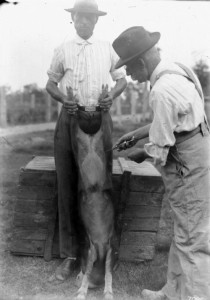In 1915, Florida’s agricultural economy was in serious trouble. Its principal cash-crop, cotton, was being devastated by the boll weevil, an invasive beetle that crossed over from Mexico in the early 1900s. Farmers were desperate to make up the loss of their cotton crop by turning to some other form of income. Domestic hogs, which could be fed with peanuts grown on the same land, were a natural choice, and farm demonstration agents, assigned to dealing with the boll weevil, urged farmers to convert their hog pens from home use to large-scale operations. But while the conversion was under way, another infestation, cholera, began killing off hogs by the thousands.
A serum-and-virus vaccination method had been developed to ward off the disease, and the Florida legislature made the serum available to farmers for free. The only problem was getting enough hogs vaccinated in time to control the cholera’s spread. Fortunately, the state already had a small army of farm demonstration agents who, under the guidance of veterinarians, could help farmers vaccinate their stock. Thus, when Extension took over farm demonstration work after the adoption of the Smith-Lever Act in 1915, the state’s 33 county agents found a population in urgent need of their help and expertise.
Not that all farmers were without skepticism about the new methods. “No sir,” said one farmer as late as 1920, “I’ll not let anyone put old dead blood in my hogs for my family to eat, or the old virus, or whatever you call it, which might poison my baby.”
Even when farmers welcomed the agents, vaccinating hogs was demanding, even dangerous work. Louis T. Nieland, Flagler County’s first Extension agent, recalls that “most of the hogs were wild, long-snouted, well-tusked, rugged individuals, capable of surviving in the extensive swamplands in competition with bears, ‘catamounts’ and large alligators…The hogs had to be trapped in the woods in high-walled log pens and, to get into the pen, vaccinate a hog, then leap over the top rail to safety required considerable know-how, agility, and sometimes, good luck.”

Despite the risks, hog vaccination became the early Extension agent’s primary duty. County commissioners, who paid much of the agents’ salaries, appointed them to cure hogs first, and attend to educational work and corn clubs later. It would take more than 60 years for hog cholera to come under complete control, but within a single year, Extension had accomplished a major feat—it had gained the public’s trust.
Sources:
Cooper, J. Francis, ed. Dimensions in History: Recounting Florida Cooperative Extension Service Progress, 1909-76. Gainesville: Alpha Delta
Chapter, EPSILON SIGMA PHI, 1976.
Smith, J. Lee. Tracks of Men: A Type of Agricultural Extension History. Unpublished manuscript, 1953.
 0
0
